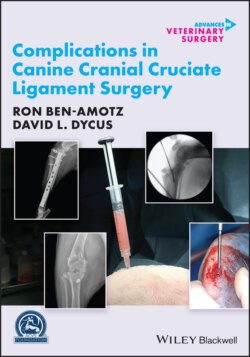Читать книгу Complications in Canine Cranial Cruciate Ligament Surgery - Ron Ben-Amotz - Страница 18
1.3 Treatment
ОглавлениеA number of methods for stifle stabilization exist. They are commonly characterized as extraarticular stabilization, intraarticular stabilization, and osteotomy modifying procedures. One of the complicating factors of stifle stabilization (and indeed, one of the reasons for the existence of so many surgical procedures) is the lack of definitive guidelines for what constitutes a successful postoperative outcome.
Figure 1.11 Evidence of joint effusion in the stifle of a patient with CCL pathology. In the caudal compartment, there is displacement of the joint capsule as can be noted by the red arrows. The opacity in the cranial compartment (blue arrows) is joint effusion that is displacing the fat pad cranially.
Figure 1.12 Evidence of degenerative changes in the stifle of a patient with CCL pathology. Commonly noted areas are the distal pole of the patella (blue arrow), cranial tibial plateau (orange arrow), caudal tibial plateau (yellow arrow), and fabella (red arrow). In addition, a small area of sclerosis can be seen around the trochlear groove (green arrow) indicative of synovitis or osteophytosis of the medial or lateral femoral trochlea.
While all correctly executed surgical procedures can stabilize the stifle, not one of these procedures ultimately restores completely normal stifle kinematics or kinetics. In defining a good outcome, should we consider a stable stifle to be the predominant deciding factor? Interestingly, work has been completed that demonstrates ongoing instability following surgical stabilization [16, 25], yet retrospective and client assessment studies have shown high success rates with certain procedures. What about return to function? Success rates among all surgical procedures are in the high 80% to low 90% range when evaluating most retrospective studies. While this suggests that most surgical procedures do a good job of returning canines to “normal” function, probably the best way to tell would be return to sport or work for our canine athletes. Recent data have suggested that following TPLO, agility dogs have a good prognosis for return to sport [26].
Elimination of progression of OA has been stated as a possible determination of outcome and goal of treatment. This is likely not an achievable feat. Once the CCL has become damaged and instability in the stifle is present, there is abnormal joint loading. Thus, damage to the chondrocytes has occurred. Therefore, it is probably better to evaluate surgical stabilization procedures in terms of which are the most capable of slowing down and minimizing progression of OA, rather than which can eliminate it entirely.
